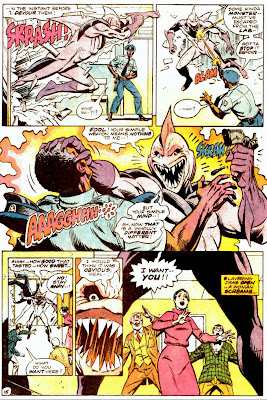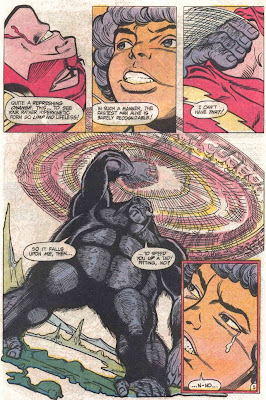Green Lantern #175-181
“Take This Job--And Shove It!”
 |
| Oh god, the yellow! Even the steamroller is yellow. |
Holy sub-plots! There's a ton of stuff
going on in these issues, so let's get to it. And yes, Green Lantern
does face a villain who happens to be outfitted with some yellow
weaponry.
Two great things about this story:
there's a focus on some pretty rad and colorful Green Lantern
villains and the writer finds a way to make Green Lantern interesting
to me. The villains on focus here are some of the odder in Green
Lantern lore. First encountered is The Shark, not a man who was
mutated into a shark, but instead a shark who encountered radiation
or toxic waste, or some other such catalyst left floating in the
ocean by a careless humanity, who is forced via rapid evolution into
a man/shark hybrid. The best part is that the villain is so angry
about this mutation, he hates humanity for it. He'd rather be a shark
swimming around. Being a man-sized shark, you'd expect The Shark to
go around eating the shit out of people right? Well, sure he can, but
instead he's telepathic. He eats your thoughts.
 |
| Why sully your teeth on flesh when mental powers will do in a pinch? |
A shark that's angry it was mutated
into a more evolved human-like form AND one which does not chow down
on people but instead messes with them with his mind. Blowing all
kinds of cliches out of the water there; The Shark is just not what
you'd expect. He also runs around in a purple unitard. That's what we
like to call 'not giving a fuck.'
Wow, spent a lot of time on The Shark.
I dig that guy. Part of my DC Universe (hence the blog) love is
definitely towards these goofy, gimmick-heavy villains. That don't
make a whole lot of sense, but damn if they're not creative and part of the fun.
 |
| Two alpha-male dicks beat up on the mentally ill. |
The story also introduces two new
rogues, one of which is the Demolition Team, a group of
deconstruction workers with inexplicably gold-plated weapons such as
a rivet gun and a jackhammer who are hired by the vengeful Congressman we met during the last story to destroy Ferris
Aircraft. The other rogue is the Predator, a mysterious black-clad
vigilante with a penchant for claws and axes. He has a stake in both
saving Ferris Aircraft as well as wooing Carol Ferris. Considering
how superheroes normally treat their significant others, I'd
recommend Carol to drop Hal like a bad habit. Yeah, the lunatic with
the axe would be a better suitor.
 |
| Think about it Carol, just think about dreamboat here. |
Let's sum up the story: Hal is attacked
by The Shark, who proceeds to mop the floor with the jade hero by
devouring his thoughts, knocking him into a psychic coma. But of
course, comic books being what they are, Hal recovers and sends
Shark-tastic packing. While all this is going on, Vengeful
Congressman hires the Demolition Team through our favorite henchmen middle-man, The Monitor. As the DTs (the comic book makes
this joke as well) proceed to trash Ferris Aircraft (sub-plot alert:
architect John Stewart is hired to fix up the airfield), mostly
seeking to prevent Ferris from turning a profit on their new solar
jet (sub-plot with Bruce Gordon and the villain Eclipso!) because
Vengeful Congressman hates Ferris.
 |
| John Stewart would even be a better Green Lantern.... |
With Hal incapacitated, sent by the
Guardians to rescue another planet in his space sector, The Predator,
who has a keen interest in Ferris succeeding with the construction of
the solar jet, appears to save the day. Too bad for the Demolition
Team that their yellow weapons don't mean anything to a psychopath
with a blade fetish. The flesh of vengeful congressmen aren't The
Predator's weakness either as he proceeds to turn Vengeful
Congressman to sushi when thus completing the whole sad affair.
Oh, and of course the second great
thing of this story besides the villains: Hal Jordan acts like a
goddamn baby and quits the Corps, relinquishing both his ring and his
superhero identity.
 |
| Cry-baby. Sorry you had to save a planet of non-humans Hal. |
Let's back up a bit, I had mentioned
that Hal had been incapacitated during the attack on Ferris Aircraft.
When he does finally show up, with Ferris in disarray,
Carol gives him all kinds of hell for not being around. What was he
doing? The Guardians, rightly, I might add, were a bit worried that
Hal, who is supposed to be the protector of an entire space sector,
multiple galaxies, is spending a bit too much of his time on one
planet protecting his girlfriend's business. Hearing that a far-off
planet when is dire need; that is, the planet's core was going to
pull a Krypton and pop like a zit, The Guardians force Hal Jordan to
get off his ass and save the damn planet.
Which he does do, admittedly,
stabilizing the core. Although he bitches about it the whole time.
He'd rather be on Earth helping his friends. He's incredibly,
pathologically selfish.
What an asshole.
He'd rather be helping his friends
business than saving an entire planet. This is the impetus for Jordan
quitting the Corps: they forced him to do something he didn't want to
do. Namely his job, but Hal doesn't see it that way.
This is where I lose Hal Jordan and
where the 'Green Lantern' title gains my interest with the promise of
a new character. So exit Hal Jordan and enter...well, I have to save
something for next time.
In the meantime, as Hal walks off to
enjoy retirement with Carol, I really hope she dumps him for The
Predator and someone throws a lemon at Hal, killing him.

























 '
'



